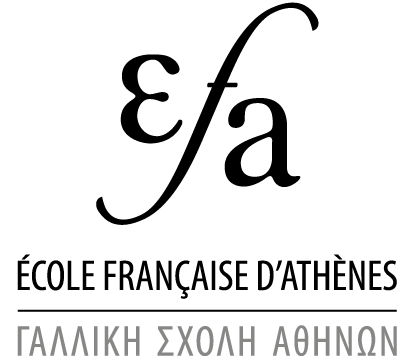The history of research: travellers and excavations
Initial exploration of Delos
Before arousing the curiosity of travellers, Delos was of interest to sailors. As a result it appears in the numerous Books of Islands (Isolarii) of the fifteenth and sixteenth centuries that were dedicated to the islands of the eastern Mediterranean. The oldest, the Liber insularum Archipelagi of the Florentine canon Christoforo Buondelmonti (1420), is also the first of these works to show Delos and Rhenea on an individual map.
These collections of maps with a descriptive text were succeeded by the long series of accounts (around a hundred between the fifteenth and nineteenth centuries) that recount a visit to the island, which were either original or inspired by previous accounts. Cyriac of Ancona, who came to Delos in 1445, was the first of these travellers – scholars, naturalists, diplomats, architects and painters – who described remains and made copies of inscriptions, while often showing an interest in both the ancient ruins and the 'wonders of nature'.
Almost all these visitors stressed the natural hostility of the island, and their visits often proved disappointing as, amongst the chaotic jumble of stone blocks visible amid the dense vegetation, few monuments could be identified apart from the Colossus of the Naxians (9), the Stoa of Philip (3), and the Theatre (114).
The FSA's work
Following the foundation of the French School at Athens in 1846, the institution sent several of its members on expeditions to the island. In 1864, after spending a month on Delos L. Terrier produced an impressive report, which included meticulous observations along with proposals for identifying remains that were often very insightful. Nine years later, in 1873, the French School sent A. Lebègue to carry out excavations. In spite of interruptions of varying lengths triggered by the need to work on other sites, the French School has never ceased to explore a site of which the richness has inspired and echoed archaeologists' and historians' interest in a range of different aspects of ancient Greek civilisation.
-
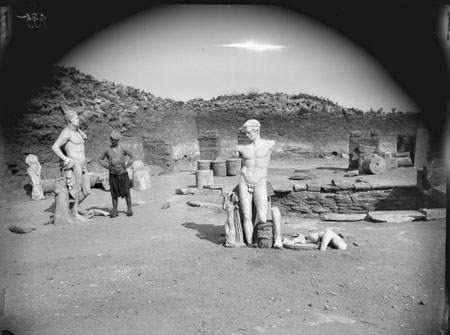
- Courtyard of the House of the Diadoumenos (61) [1894]
Until the First World War, on the instigation of T. Homolle and then M. Holleaux, the emphasis was on the clearing of large areas in the Sanctuary zone and on the northern slopes of Cynthus, although the rest of the island was not neglected. Several years apart (1894 and 1907), two archaeological maps of the island were drawn up, while a study of its physical geography was successfully completed by the geologist L. Cayeux (EAD IV).
From 1903 onwards, the excavations enjoyed annual financial support from Joseph Florimont, Duke of Loubat (1831-1927), a rich American philanthropist and foreign corresponding member of the Academy of Inscriptions and Belles-Lettres. This major contribution to work in the field was complemented in 1920 by the creation of a Greek epigraphy fund to support the Institute, from which the income was used for the publication of the Choix d'inscriptions de Délos by F. Durrbach (1921) and the Corpus des inscriptions de Délos.
-
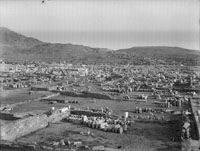
- Overview of the excavation site [1907]
-
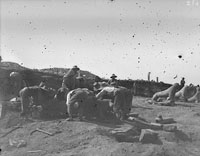
- The Terrace of the Lions (55) during the excavation [1906]
-
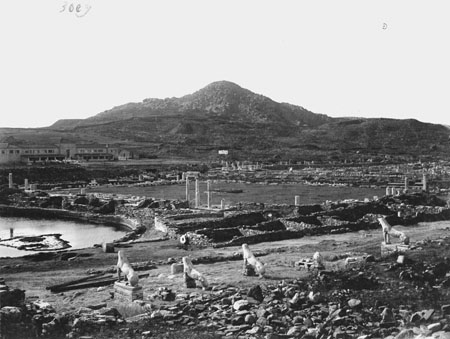
- The Terrace of the Lions (55), the Agora of the Italians (52), and Mount Cynthus [1910]
From the 1920s onwards, the efforts of the School's members focused on the study of monuments, batches of equipment and inscriptions discovered in the previous decades, and exploratory research concentrated more on buildings than groups of monuments.
Between the end of the 1950s and the end of the 1970s, several large houses (including the House of Hermes, 89, and the House of Fourni, 124) and the insulae of dwellings forming the 'Northern Quarter' to the south of Skardhana bay were excavated, and interest was also shown in Rhenea, especially its necropolis.
After the beginning of the 1980s, a number of one-off excavations of monuments that had been discovered in the past were carried out, in order to see their publication through, while the rural areas of both Delos and Rhenea was the subject of preliminary surveys and excavations.
Conclusion
From the beginning, the research carried out on Delos by French archaeologists was complemented and enriched by the work of the members of the Greek archaeological service and foreign researchers, who were always associated with the exploration XXXXXXX. For a decade the international nature of Delian studies has been growing, with the publication of several monographs and synoptic works in Greek, German and English.
Although a large part of the remains of the town of Delos are still under the ground, what research has so far achieved is considerable. Today, however, the preservation and restoration of the remains have become a priority, as well as making them ready for tourists, who are coming in greater and greater numbers. In recent years, several rooms in the Museum have been given a new look and, at the site, casts are taking the place of originals. Nevertheless, in spite of the site's inscription on the UNESCO World Heritage list in 1990, the funds available to restorers are far from sufficient to deal with the slow but inexorable deterioration of the ruins.
© EfA / Guide de Délos 4th ed.
